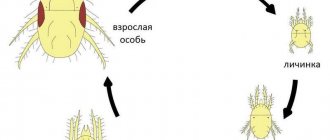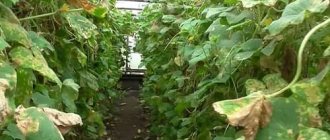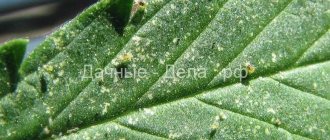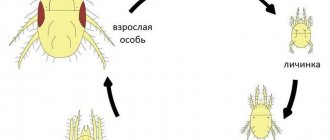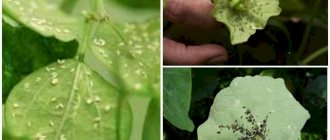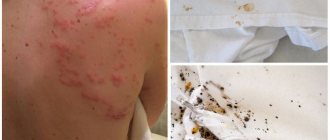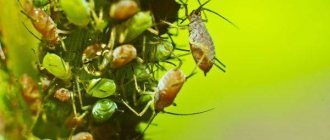One of the most common pests that can affect both garden and indoor plants is the spider mite. This small arachnid attacks berry and fruit trees, it settles on grapes and mercilessly destroys ornamental shrubs and flowers. His favorite plants include roses. Moreover, it can parasitize both climbing and bush species. Spider mites appear on roses quite often and as a result, this beautiful flower begins to weaken, loses leaves and becomes much more susceptible to various diseases.
Spider mite on a rose
The insect settles on both home and garden flowers. The mite attacks various plants, but most of all it loves strong and juicy roses. The difficulty of eliminating the parasite is that it develops rapidly, and although its lifespan is short, up to 1 month, during this time the female manages to lay thousands of eggs.
How does a mite get on a flower?
The carrier of mites is the wind, which carries them from one plant to another.
Spider mites are one of the most destructive insects for roses.
The insect is carried into the apartment on shoes and items of clothing, and with the wind - through windows.
Preventive actions
It is much easier to take simple preventive actions than to deal with severe consequences later. To minimize the likelihood of infection, the lower leaves should be ventilated as often as possible. If you have purchased a new flowerpot, you cannot place it with the others; it must be quarantined for some time to make sure that it is not infected and does not pose a danger to other flowers.
Indoor conditions are very important for roses; you must try to maintain a comfortable temperature and humidity. Get rid of fallen leaves. Wet clean the window sill using a soap solution as often as possible. Remember that roses do not like being next to orchids.
Brief description of the pest
Spider mites on indoor plants - how to fight
It is difficult to notice spider mites on a rose in time until the first symptoms of plant infection appear. The parasite is microscopic in size. Brief description of the pest:
- the body shape is oval, the number of legs is 8, the limbs are located in 4 pairs on both sides;
- adult sizes: females - from 0.4 to 0.6 mm, males - up to 0.4 mm;
- the body is flat below, slightly convex at the top, covered with small, soft bristles;
- color - at the larval stage the body is transparent, the adult tick is light green or green with a brown tint, with dark spots on the sides.
Microscopic size is an advantage of the parasite
Additional Information. Females acquire a bright red or deep red color from autumn to spring.
Why is a mite called a spider mite?
The mite got its name because when it settles on a plant, it begins to weave numerous threads of a web, quite dense, which in a short period can completely cover the rose.
Habitats
The parasite lives all over the globe. The only place where it is not present is Antarctica.
Reproduction
In early spring, ticks begin to actively reproduce. The female lays about 7 eggs per day, which she attaches to the threads of the web or foliage. Egg diameter 1 mm. The rate of reproduction depends on climatic conditions. Ticks show maximum activity at a temperature of about +25 degrees. In tropical latitudes and in greenhouses, parasites reproduce all year round, reproducing offspring every month.
Additional Information. For the winter, females hide their eggs in cracks in the bark or among fallen leaves. In moderate frosts, future offspring survive until the onset of a thaw.
Causes of infection
Where do spider mites come from on rose bushes? As a rule, it is simply brought by the wind, and most often this happens in dry weather. Dusty conditions are created in which the parasite first falls on plants located along the outermost line of the garden. Moreover, these can be trees, shrubs, and herbaceous plants.
With each subsequent flow of wind, spider mites spread throughout the garden, and if roses grow in it, then the parasites will certainly end up on them too. And if rose bushes do not receive proper care, they become much more susceptible to infection by these pests. But there is good news - birds, sudden cold snaps and rainy weather help to somewhat reduce the number of colonies. However, these factors are unable to completely solve the problem.
As for the infection of roses that grow in an apartment, the main reason in this case is the warm, dry climate. And if spider mites were brought into such a room, for example, on new plants, then they will certainly remain and, under favorable conditions, will quickly multiply.
On a note! The lifespan of a spider mite is relatively short - about a month and a half, but during this time the female alone will have time to lay a hundred or two eggs, from which new individuals will hatch and continue to destroy your roses!
Signs of rose mite damage
Aphids on houseplants - how to fight them at home
While the mite itself is difficult to see due to its small size, the consequences of damage to the rose are clearly visible. There are a number of signs that indicate a plant is infected with a parasite:
- The rose gradually fades and becomes painful in appearance.
- The leaves are covered with a white coating, which gradually increases in diameter and eventually forms into separate spots.
- The appearance of thin threads of cobwebs.
- Twisting of leaf plates, after which they begin to dry out.
- The foliage becomes pale and yellow.
- Inflorescences decrease in size and become weak.
You can tell that a rose has become a victim of a mite by the suddenly changed appearance of the foliage.
When the first symptoms of infection are detected, it is necessary to urgently take measures to eliminate the parasite, otherwise the rose will die in a short period of time.
White spots on leaves
White spots begin to appear due to the fact that the parasite sucks the juice from the plant cells. Gradually, the cells die, metabolic processes are disrupted, and the leaf blade dies. Sucking the juice negatively affects the entire flower, it weakens and becomes too susceptible to various diseases.
Wilting and yellowing of foliage
After white spots appear, the leaf blade, deprived of juice, begins to turn yellow and curl. At first, individual leaves fall off, but as the mite colony spreads throughout the flower, a massive leaf fall occurs.
Additional Information. You can check the bush for ticks using the following method - place a white piece of paper under the flower and shake the branches. If there are parasites, they will fall from the rose onto the paper.
Presence of a web
If the withering of foliage and its falling off is not a specific sign, since such a symptom is characteristic of many parasites, then the presence of cobwebs on a rose outdoors or indoors leaves no room for doubt.
The web spreads gradually. At first there are several thin threads, then their number increases, and soon the entire flower is covered with it.
Methods for controlling spider mites
Scale insects on indoor plants - how to fight at home
The spider mite is the most dangerous parasite for roses, which not only destroys the plant where it settles, but also quickly spreads to neighboring flowers. It is difficult to fight it, but it is possible if you take timely measures.
Isolating plants in the garden and in the house
As soon as cobwebs are noticed on domestic roses, they should be immediately isolated in a separate room. This is done in order to prevent the parasite from spreading to other plants.
Insulation is more difficult in the garden. The rose bush can be covered with a darkening mesh or agrofibre.
A stream of water will help knock off most of the parasites from roses, which will greatly facilitate further war against them.
Note! Before covering or isolating a flower, it is necessary to remove as many parasites as possible from it. You can carry out mechanical cleaning using a shower, under which you place a pot with an indoor rose. Garden flowers are doused with water from a hose under pressure.
Drastic bush pruning
Damaged parts of the rose cannot be restored. They need to be trimmed.
Cleaning leaves from cobwebs
The cobwebs are removed from the bush by hand; they can be wound around a stick. Small parts of the threads are washed off with water under pressure.
Spraying
A soap solution is highly effective in removing mites and cobwebs. They need to spray the infected bushes.
A few words about the pest
The spider mite is a small oval-shaped arachnid insect, 1 millimeter in size, red in color (the larvae are light green).
Plant sap is the main food of the pest. The insect is an omnivore; it attacks absolutely all plants it comes across on its way. Can be transported over long distances using its web. At air temperatures above +23 degrees, the mite multiplies quickly, laying up to several hundred eggs on the leaves. The larvae are particularly gluttonous - they drink plant juice. In this case, the process of photosynthesis is disrupted, the plant is depleted and dies. Attention!
Spider mites most often attack young bushes that do not have strong immunity. When exposed to the pest, such bushes do not have time to form buds.
A cobweb appeared on the rose, what to do at home - folk methods
You can rid a plant of the parasite using folk methods and specialized purchased products. The first is preferred because they are safer. But recipes made from natural products show effectiveness only in the early stages, when the parasite colony is not yet too large.
Onion tincture
Pour 100 g of onion peel into 5 liters of hot water. Leave for 5 days, then strain. Spray the bushes generously. Repeat the procedure every 2 days until the tick is destroyed.
Dandelion decoction
Spider mites cannot tolerate the smell of dandelions, and upon contact with it they will prefer to leave the bush. To prepare the decoction, add 2 liters of water to 40 g of dandelion and leave for 5 hours.
Roses should be sprayed at close range and generously.
Garlic tincture
Garlic tincture, which will help eliminate the parasite from roses, can be prepared according to several recipes:
- Chop the garlic head and pour 10 liters of hot water into it. Use only after the liquid has cooled completely.
- Grate the garlic. Pour 50 g of the ingredient into 3 liters of water and place the container in a dark place. Infuse for 7 days. Strain. The resulting concentrate must be diluted before use - pour 60 g of the prepared solution into 10 liters of water.
- Finely chop the garlic head and pour in 10 liters of slightly warmed water. Leave for several hours, strain.
Additional Information. To enhance the effectiveness of garlic tincture, you can add crushed laundry soap to it.
Soap solution
A solution of laundry soap is one of the most popular and quite effective ways to eliminate any parasites on roses, including spider mites. Recipe:
- Grind a piece of laundry soap on a grater.
- Pour in water and shake the container well until foam forms.
- Apply the prepared solution to the bush through a spray bottle.
Recommendations for using a soap solution that will help increase its effectiveness:
- Instead of laundry soap, you can use tar soap.
- It is necessary to treat with the solution not only the green part of the bush, but also the stem, as well as the ground under the plant.
- After 4 hours, the white coating formed from the soap must be washed off with a stream of water and cover the plant with film for a day.
Note! When spraying the stem and soil, do not allow the soap solution to get on the root.
Use of predatory insects
Spider mites can be eliminated from a plant by attracting insects that are the parasite’s natural enemies. These insects include:
- ladybug;
- lacewing;
- riders;
- bedbugs;
- common earwig.
These insects will help save the flower if you attract them to the site. To lure predators, you can use the following tricks:
- Plant flowering plants, as insects need nectar for reproduction.
- If possible, leave a few weedy bushes in the area where lacewings like to breed.
- Sow chamomile, dandelion, coltsfoot, oregano and rosemary.
The easiest way is to collect ladybugs by hand and move them to the rose
In summer, pots of hay can be placed on the site. The same recommendation can be used for flowers in the house. In winter, hay can be placed in a pot with Chinese rose and other domestic flower varieties.
Additional Information. The mite most often infects plants in rooms with dry and warm air. This is an ideal environment for the parasite to reproduce. The insect is afraid of cold and high moisture.
Additional events
You should always monitor the condition of the flowers and take immediate action at the slightest sign of infection. If a parasite is noticed on a plant, it is necessary to rinse it with warm running water, and then wipe the leaves with a low concentration alcohol solution.
Next, you need to choose the most suitable product and treat the rose. Remember that you will also need to treat the window sill and the area where the flowerpots are located. The procedure must be repeated after a week. In order to protect the rose, fertilizer with potassium is applied after the repeated procedure.
Preparations for spraying
If you find a cobweb on a garden rose, what should you do? If the flower is extensively damaged, recipes based on natural products will not help, which is why you have to resort to store-bought drugs. Best chemicals to treat roses:
- Actellik is a potent drug that is used only in extreme cases when other methods do not produce results. When used on house flowers, treatment is carried out only on the balcony, where there should be no animals or children. When working with Actellik, the gardener must wear gloves and protect the organs of vision and breathing.
- "Fitoferm" - shows high efficiency in relation to larvae and adults. Use once a week until the parasite disappears completely.
- "Neoron" - destroys eggs, larvae and adult ticks. The drug is used 2 times with an interval of 1 month.
On a note! "Fitoverm" is a preparation that can be used to treat plants indoors. Despite its low toxicity, it shows high results in exterminating ticks. The parasite dies 5-6 days after spraying the rose.
Other drugs recommended for killing ticks:
- "Fufanon";
- "Demitan";
- "Karate";
- "Sunmite";
- "Apollo".
Homemade recipes for ticks can be used a few days after purchasing chemicals to achieve the fastest results.
How to care for a rose: 4 rules of care
To ensure that roses are not weak and can resist diseases and pests, they need to be carefully looked after:
| Rule 1. Feeding Feeding is an important stage in rose care:
| |
| Rule 2. Watering Water roses no more than once a week. During drought, you can water the bushes more often. The water should be of medium temperature and poured under the root. Watering rate - 1 bucket per bush | |
| Rule 3. Prevention An obligatory stage of caring for a rose is its prevention from pests and diseases: spraying with water and insecticides, destruction of plant debris, quarantine and soil selection | |
| Rule 4. Trimming Shoots that grow inward, fading and damaged rose branches need to be pruned. If you cut off excess shoots in time, young shoots and flowers will form more actively |
Learn more about proper rose care in the video:
Prevention
So that you don’t have to think about how to fight spider mites on roses at home, you need to follow preventive measures and properly care for your flowers. Simple measures will help prevent the appearance of a parasite, from which roses begin to dry out and then die:
- Periodically wash the plant with a stream of water.
- Isolate the purchased rose from other plants for several weeks.
- Maintain an average level of humidity; the air in the room should not be too dry.
- Remove withered leaves from the area and burn them.
- Inspect roses weekly for parasites.
Note! Having noticed a web on a rose bush, you must first make sure that it was left by a mite, and only then take any measures, since the flower may become covered with white threads due to the fact that a spider has settled in it.
Spider mites are a parasite that is destructive to roses. Plants indoors are extremely difficult to cure and recover from insect damage. Roses that grow on the site have a higher chance of survival. Knowing what a flower affected by a mite may look like, it is necessary to immediately begin fighting it before the parasite colony increases. It is important not to forget about regular preventive measures.
Remember
- The fight against ticks must be started on time, otherwise it will be much more difficult to get rid of it, since it multiplies quickly.
- Be sure to follow preventative measures for roses to protect them from ticks or other parasites.
- Care for roses properly so that they are not weakened. Diseases and pests most often choose weak and neglected plants, since they cannot resist disease.
- Follow safety rules when working with chemicals so as not to harm your health: carry out work only in a respirator and gloves, do not drink or eat during work, and afterward wash your hands and face thoroughly with soap.

